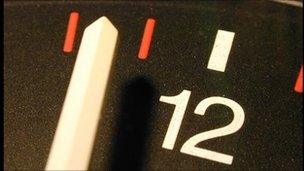Net approaches address exhaustion
- Published

Time is running out for the internet's current addressing scheme
The last big blocks of the net's dwindling stock of addresses are about to be handed out.
The event that triggers their distribution is widely expected to take place in the next few days.
When that happens each of the five regional agencies that hand out net addresses will get one of the remaining blocks of 16 million addresses.
The addresses in those last five blocks are expected to be completely exhausted by September 2011.
Final five
The trigger event will likely come from the agency that oversees net addresses in the Asia-Pacific region, a body known as Apnic.
When Apnic's store of addresses falls below a key threshold, said Geoff Huston, chief scientist at the agency, it will ask for more from the central repository - the Internet Assigned Numbers Authority (IANA).
"When IANA process this request that will leave it with five /8s in its pool," said Geoff Huston, chief scientist at the Asia Pacific registry.
A "/8" is the biggest block of net addresses that IANA hands out and comprises about 16 million addresses.
"That will trigger the IANA to activate its 'final /8' actions, which entail the IANA handing out a final /8 to each of the five regional internet registries," said Mr Huston.
IANA is expected to formally hand over the final five in a ceremony in mid-March that will signal the beginning of the end for this pool of addresses.
The internet was built on version 4 of the Internet Protocol (IPv4) which has an upper limit of about four billion addresses. In the 1970s when IPv4 was drawn up this seemed enough but the explosion in the use of the net has led to its rapid depletion.
Making plans
Axel Pawlik, managing director of RIPE which hands out net addresses in Europe, said he expected the entire stock to run dry in September 2011.
"It might be earlier," he said "as we have had some quite significant growth."
"There have been a lot of big requests for addresses," he said, "specifically in the US and Asia but that's not a surprise as they have all the people there and the growth too."
Mr Pawlik said Ripe and other regional registries have been rationing requests for addresses for some time. Enough addresses to last two years used to be given out, he said, but now it only supplied sufficient to last six months.
The 16 million addresses in the last block /8 assigned to Europe could run out quickly, he said, as people woke up to the fact that there are not many left.
Plus, he said, Ripe and other agencies were planning to reserve a chunk of addresses for new entrants and to help with migration to the new addressing scheme - IP version 6 (IPV6).
While number of requests for IPv6 addresses was rising, said Mr Pawlik, it was not happening fast enough.
"If you do not have any plans for IPv6 now you are irresponsible," said Mr Pawlik, "They should have that in place, if they do not have that by now something is going seriously wrong."
Mr Pawlik said there would not be chaos once the IPv4 addresses were used up. However, he said, it made sense to start switching as the technical work-arounds to cope with a lack of IPv4 addresses were unwieldy and limited.
"IPv6 is the solution," he said.
- Published11 November 2010
- Published13 January 2011
- Published30 November 2010
- Published11 May 2010